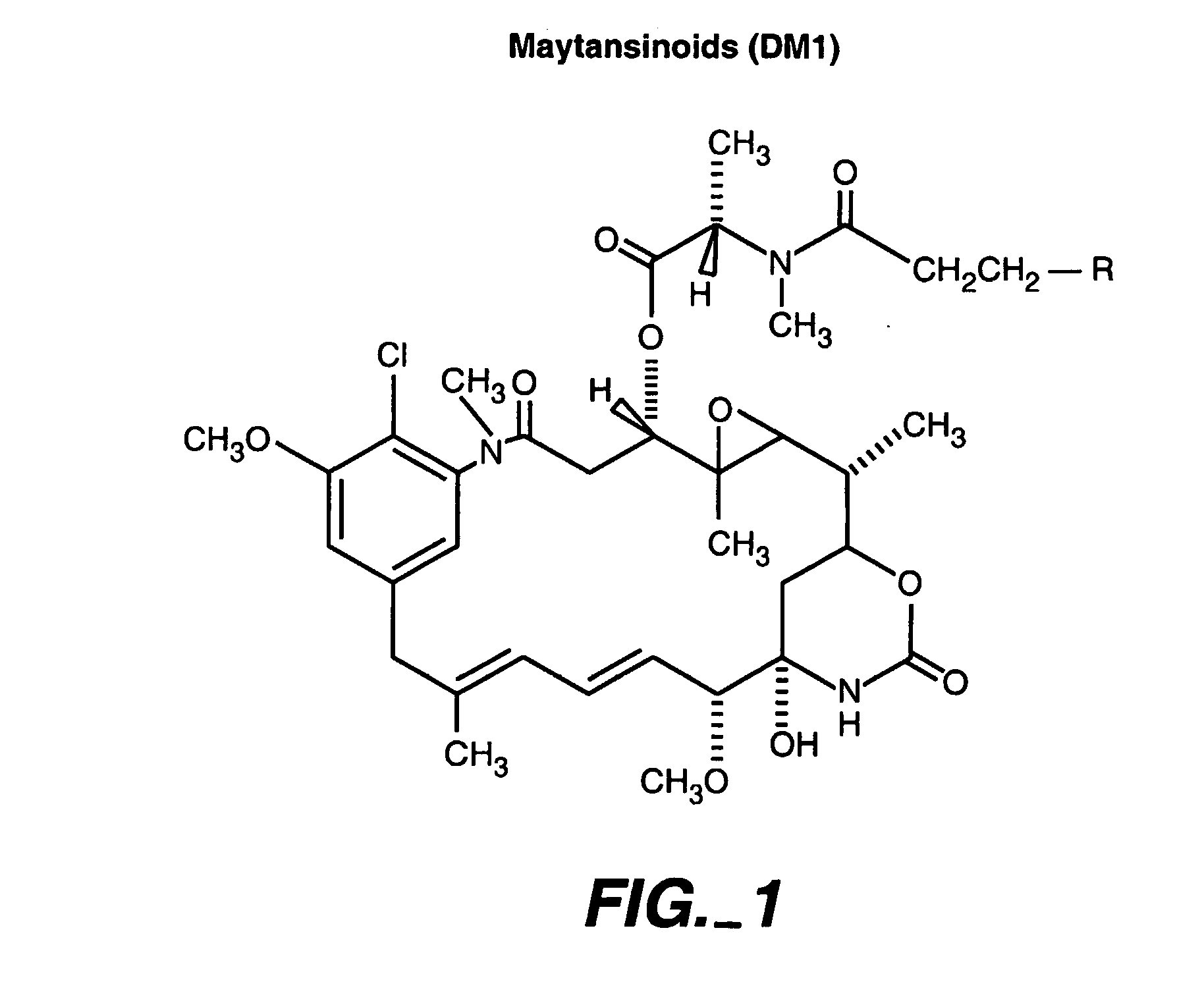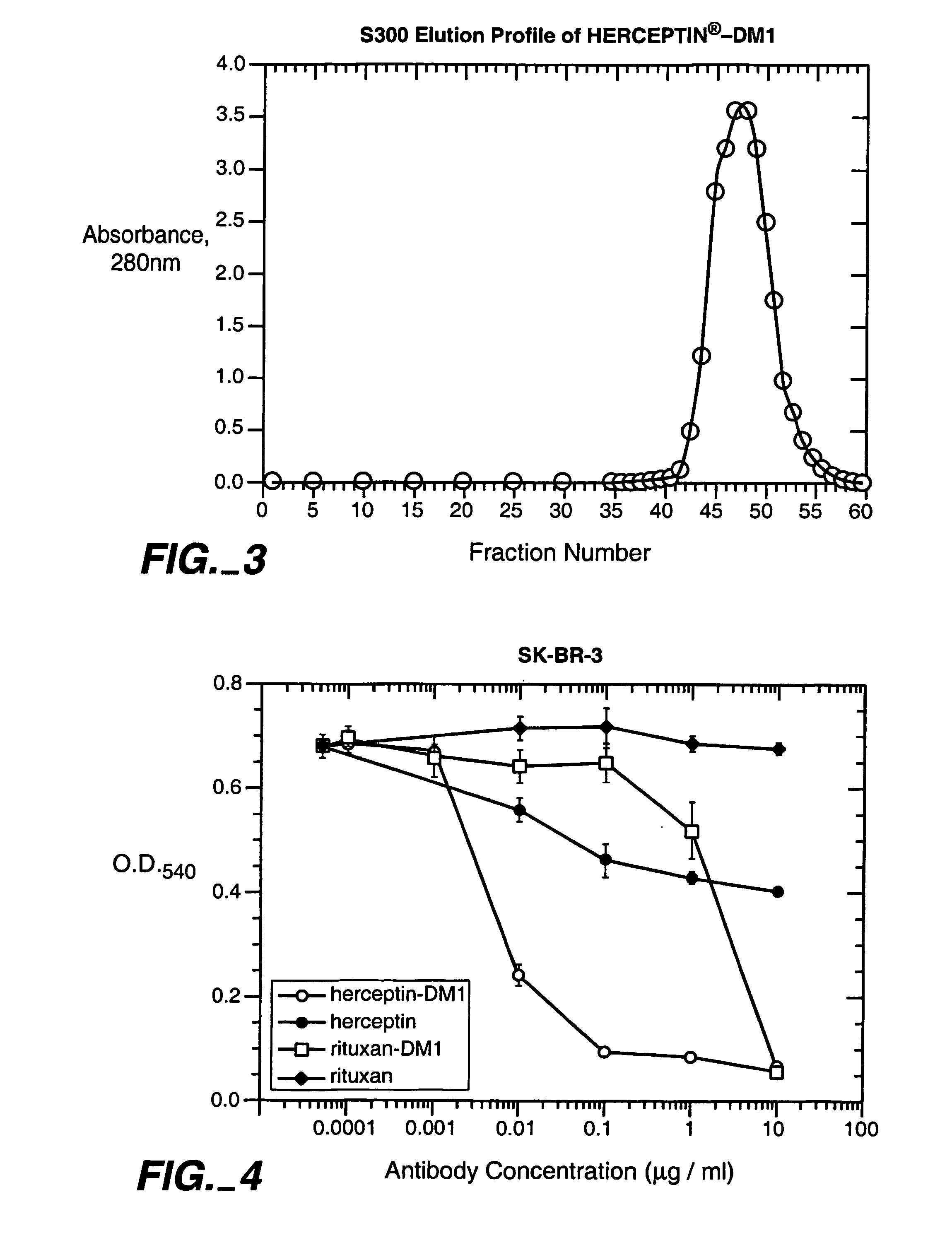Methods for the identification of polypeptide antigens associated with disorders involving aberrant cell proliferation and compositions useful for the treatment of such disorders
a polypeptide antigen and aberrant cell technology, applied in the field of polypeptide antigens associated with aberrant cell proliferation disorders and compositions useful for the treatment of such disorders, can solve the problems of radiotherapy having several undesirable complications, abnormal cell proliferation, cell death, etc., and achieve the effect of limited general toxicity
- Summary
- Abstract
- Description
- Claims
- Application Information
AI Technical Summary
Benefits of technology
Problems solved by technology
Method used
Image
Examples
example 1
6.1. Example 1
HERCEPTIN.RTM.-DM1 Conjugates
[0288] 6.1.1. Purification of HERCEPTIN
[0289] HERCEPTIN.RTM. (huMAb4D5-8, rhuMAb HER2, U.S. Pat. No. 5,821,337) (1 vial containing 440 mg antibody) was dissolved in 50 mL MES buffer (25 mM MES, 50 mM NaCl, pH 5.6). The sample was loaded on a cation exchange column (Sepharose S, 15 cm.times.1.7 cm) that had been equilibrated in the same buffer. The column was then washed with the same buffer (5 column volumes). HERCEPTIN.RTM. was eluted by raising the NaCl concentration of the buffer to 200 mM. Fractions containing the antibody were pooled, diluted to 10 mg / mL, and dialyzed into a buffer containing 50 mm potassium phosphate, 50 mM NaCl, 2 mM EDTA, pH 6.5.
[0290] 6.1.2. Modification of HERCEPTIN.RTM. With SPP
[0291] The purified HERCEPTIN.RTM. antibody was modified with N-succiniidyl-4-(2-pyridylthio)pentanoate (SPP) to introduce dithiopyridyl groups. The antibody (376.0 mg, 8 mg / mL) in 44.7 mL of 50 mM potassium phosphate buffer (pH 6.5) conta...
example 2
6.2. Example 2
Lack of Toxicity With HERCEPTIN.RTM.-DM1 Conjugates
[0297] The following experiment demonstrates the lack of in vivo toxicity associated with HERCEPTIN.RTM.-DM1 conjugates.
[0298] 6.2.1. Experimental Design
[0299] HERCEPTIN.RTM.-DM1 was administered to young adult female cynomolgus monkeys (Macaca fascicularis; Primate Products, Inc., Miami Fla.) once weekly for four weeks. The average weight of the monkeys was three kilograms (range from 2.7 to 3.4 kilograms). A total of eight monkeys, divided into four groups of two monkeys each, were utilized for the study. The dosages of HERCEPTIN.RTM.-DM1 tested were 2, 10 and 30 mg / kg. A control group received vehicle only (an aqueous buffer (pH 5.0) containing sodium succinate (10 mM), sucrose (100 mg / ml) and Tween 20 (0.1%)) at the same dose volume as administered to the treated animals. Th monkeys were analyzed for various toxicities, including, but not limited to, neurotoxicity and cardiotoxicity. Table 2, below, more particular...
PUM
 Login to View More
Login to View More Abstract
Description
Claims
Application Information
 Login to View More
Login to View More - R&D
- Intellectual Property
- Life Sciences
- Materials
- Tech Scout
- Unparalleled Data Quality
- Higher Quality Content
- 60% Fewer Hallucinations
Browse by: Latest US Patents, China's latest patents, Technical Efficacy Thesaurus, Application Domain, Technology Topic, Popular Technical Reports.
© 2025 PatSnap. All rights reserved.Legal|Privacy policy|Modern Slavery Act Transparency Statement|Sitemap|About US| Contact US: help@patsnap.com



